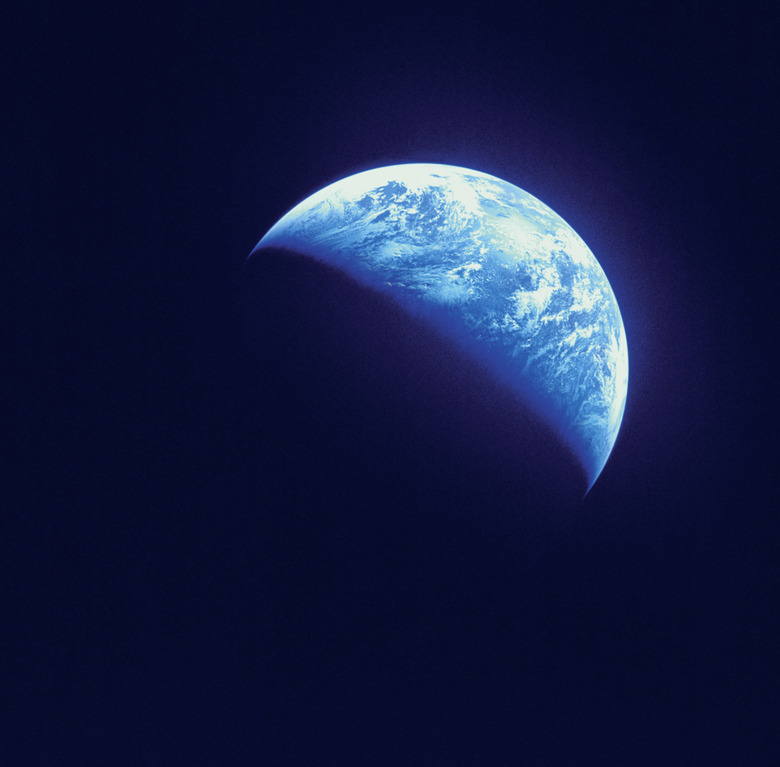Explaining The Phenomenon Of Global Warming
Global warming refers to the recent pattern of temperature increases in the earth's atmosphere and oceans, attributed in part to human activity. The scientific evidence for global warming is overwhelming, but the political debate continues. Part of the reason for the continuing debate is that climate science is a complex subject. Climate itself is the result of the interaction among dozens of factors. Because of that, you can't just observe changes in one element and connect them to a specific climatic effect — which makes explaining global warming a challenge.
Balance
Balance
The Earth receives 84 terawatts of solar power every moment — that's 84 million million watts. Some of that energy is directly reflected from the Earth's atmosphere and the surface of the Earth. Some is absorbed — heating up the air, water and land. The warmer air, water and land emit invisible infrared radiation that heads back into space. But some of that infrared radiation doesn't make it to space — it gets reflected right back to the surface. It's trapped.
A pot of heating water on the stove feels warm and it steams. The heat you feel and the steam you see are both ways the pot is getting rid of energy, but more energy comes in than goes out — so the pot heats up. The same thing occurs with the Earth: If more energy comes in than goes out, the Earth heats up.
Radiation Balance
Radiation Balance
If the Earth doesn't get rid of the 84 terawatts of power it receives at every moment, it heats up. Many factors influence the Earth's radiation balance. Snow and ice, for example, reflect sunlight right back into space. If snow and ice melt and are replaced with dark blue water or brown soil, the Earth absorbs more energy.
Another factor is that the sun has natural variations in output — meaning that sometimes the Earth receives a little more or a little less than 84 terawatts. Volcanoes eject dust that can both make the clouds more reflective and make the atmosphere absorb more energy, depending upon the specifics of the particles.
Another factor getting a lot of attention is emission of the so-called greenhouse gases. They get that name because they function like the panes in a greenhouse — they let light in, but they reflect the infrared radiation back toward the surface.
A Metaphor
A Metaphor
One way to think of global warming is to imagine your car sitting in a parking lot on a sunny day. Suppose you've figured out just how far to lower your windows so that your car doesn't get too hot. Your windows let light in and don't let much infrared back out, so the inside gets warm, but you've balanced it so enough heat escapes from your windows to keep the car comfortable. But if you spray your windows with a coating that still lets visible light in but reflects more infrared heat back into your car, the balance would be thrown off. Your car would hold more energy and heats up.
The same kind of thing happens with greenhouse gases. The natural atmosphere holds gases that reflect some infrared heat back to the Earth. Human activity is adding to the level of greenhouse gases, increasing the reflection, changing the balance and making the average temperature go up.
Why Scientists are Sure
Why Scientists are Sure
The vast majority of scientists believe human activity is influencing global climate. Even though there are many factors — some human and some natural — scientists are sure human activity is raising the average temperature of the Earth. They've looked at all sorts of evidence, from the composition of coral to pockets of water trapped within Antarctic ice. The evidence shows that climate variation has always been part of the Earth's natural cycles. But it also shows that climate changes have never — in the past 10,000 years — been as rapid as today's changes. One of those changes is the rise in atmospheric carbon dioxide, a greenhouse gas whose levels are dramatically rising because of fossil fuel emissions and deforestation. The size and speed of the changes lead to the conclusion that humans are modifying the Earth's climate.
As an example, for 1,000 years the average global temperature had stayed within about half a degree Celsius — 0.9 degrees Fahrenheit. In the mid-1800s or so temperature began to climb, then in the latter stages of the 20th century it climbed even faster. In the last 100 years the temperature has risen about 1 degree Celsius (1.8 degrees Fahrenheit). To put it simply, the temperature has risen more in the last 100 years than it did in all of the 900 years before.
References
- University of Oregon: Basics of Solar Energy
- The Center for Integrated Study of the Human Dimensions of Global Change: Teachers' Guide to High Quality Educational Materials on Climate Change and Global Warming
- ClimateChange.net: An Overview of the Climate Change Problem
- National Oceanic and Atmospheric Administration: Ensemble Reconstruction Constraints on the Global Carbon Cycle Sensitivity to Climate
Cite This Article
MLA
Gaughan, Richard. "Explaining The Phenomenon Of Global Warming" sciencing.com, https://www.sciencing.com/explaining-phenomenon-global-warming-19998/. 24 April 2017.
APA
Gaughan, Richard. (2017, April 24). Explaining The Phenomenon Of Global Warming. sciencing.com. Retrieved from https://www.sciencing.com/explaining-phenomenon-global-warming-19998/
Chicago
Gaughan, Richard. Explaining The Phenomenon Of Global Warming last modified March 24, 2022. https://www.sciencing.com/explaining-phenomenon-global-warming-19998/
